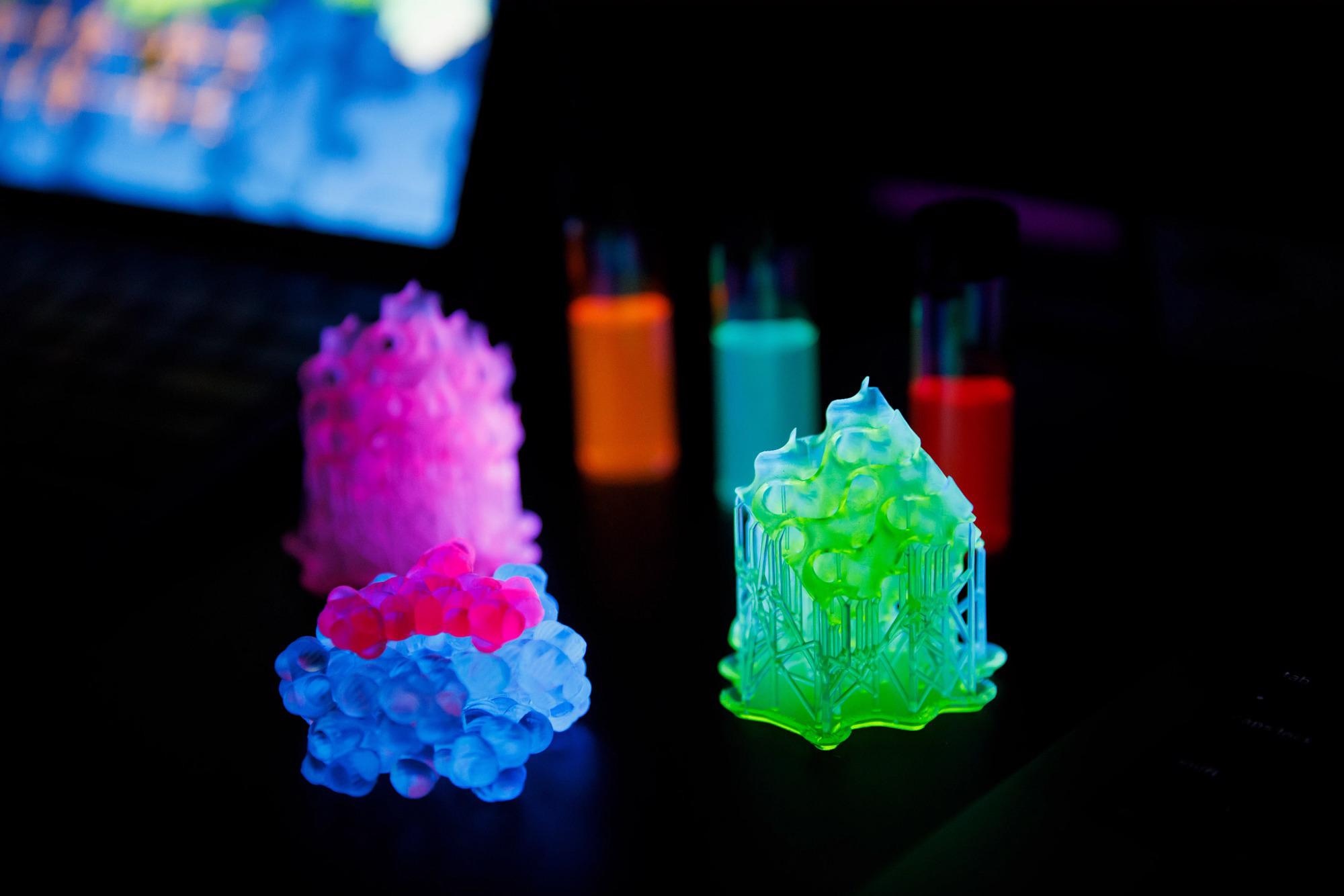Reviewed by Alex SmithJun 16 2022
A federal grant program to impel the global competitiveness of the United States by expediting the manufacture of high-tech materials has granted $1.8 million to Indiana University scientists who discovered the brightest-known fluorescent solid materials in the world.
 3D printed SMILES materials containing fluorescent dyes emit a luminescent glow under ultraviolet light. Image Credit: James Brosher, Indiana University.
3D printed SMILES materials containing fluorescent dyes emit a luminescent glow under ultraviolet light. Image Credit: James Brosher, Indiana University.
Amar Flood, Krishnan Raghavachari, and Sudhakar Pamidighantam of IU Bloomington will receive financial support from the National Science Foundation’s Designing Materials to transform and Engineer the Future program, or DMREF, to progress research on SMILES.
SMILES, also called small-molecule and ionic isolation lattices, are an inventive new material created at IU with the potential to progress technologies like solid-state lasers, solar panels, 3D displays, and medical imaging devices.
SMILES have an unparalleled brightness that does not dim or alter the color at the time of the production process. It is a general issue in the manufacture of brightly colored solids.
SMILES are a foundational material—a totally new material. There’s never been anything quite like them, so this grant will help us understand more about their properties, as well as how they might be used to improve existing technologies or advance new ones.
Amar Flood, Indiana University
The study performed under the award will integrate computational chemistry, experimental chemistry, and data science research headed by Flood, Raghavachari, and Pamidighantam, respectively.
Moreover, the findings will instantly benefit the Hoosier industry via Halophore, a downtown Indianapolis-based company that was established in 2020 to examine the commercial applications of SMILES technology. Halophore consists of active collaborations with collaborators in academia and industry.
SMILES are truly unique-not just in terms of the science but also because these materials are a ‘platform’ technology. Most materials discoveries have narrow commercial potential. In contrast, SMILES possess a remarkable combination of unprecedented features and versatility—and there’s a lot more territory to explore.
Chris Benson, CEO, Halophore
Benson who earned a Ph.D. as a researcher in Flood’s laboratory at IU added, “I think the most exciting part of this grant is that we're going to learn a lot in a very short time. These discoveries will augment the technology, as well as break open new opportunities we hadn't even considered.”
SMILES’ strong brightness is due to “molecular glue” that organizes the dye molecules into tightly packed solids along with a checkerboard lattice. The main ingredient in this “glue” is known as “cyanostars”. It is a unique macrocyclic molecule that was initially synthesized in Flood’s laboratory in 2013.
The scientific and commercial potential of SMILES stems from their potential to convert brightly colored liquid materials into a stable crystalline solid. Solar panels, for instance, capture energy from infrared light making use of specifically colored components that depend on a process known as up conversion. This works well in a liquid state at present.
In the same way, 3D-display technology — a nascent technology that relies on flat-panel screens along with pixels that tend to rotate light up to 360 degrees utilizes dyes that only function well in liquid form. The potential to produce such technologies in the absence of liquid components provides considerable benefits.
Any time you’re using liquid in a system, you're increasing the chances of degradation or mechanical failure, and decreasing energy efficiencies. In terms of the usability, going from a liquid state to a solid state significantly increases a material's durability, longevity and efficiency.
Amar Flood, Indiana University
As per the grant, the aim of IU researchers includes the creation of an open-source database and crystal engineering rules for arranging dyes with various charges, shapes, and other chemical properties. Such measures will progress the development of optical materials that could profit from SMILES.
Flood stated this collaborative and data-driven method of materials design constitutes an enhancement over past techniques of making new or enhanced materials in chemistry. This always used to be reliant upon an expensive and laborious process of trial-and-error.
The use of data science to expedite material design aligns with the DMREF program’s aim of aiding the Materials Genome Initiative for Global Competitiveness. This targets to “deploy advanced materials at least twice as fast as possible today, at a fraction of the cost.”
Flood is the James F. Jackson Professor of Chemistry in the IU Bloomington College of Arts and Sciences’ Department of Chemistry. Raghavachari is an IU Distinguished Professor and Pamidighantam is an adjunct professor in the department.
Pamidighantam is a senior scientist in the IU Cyberinfrastructure Integration Research Center under the Pervasive Technology Institute. Bo Laursen of the University of Copenhagen, a collaborator on the grant, is a co-creator of SMILES.
The creation of Halophore and the patent of SMILES were streamlined by the IU Innovation and Commercialization Office, which helps determine, safeguard, and commercialize technology that has been developed by the scientists of IU.